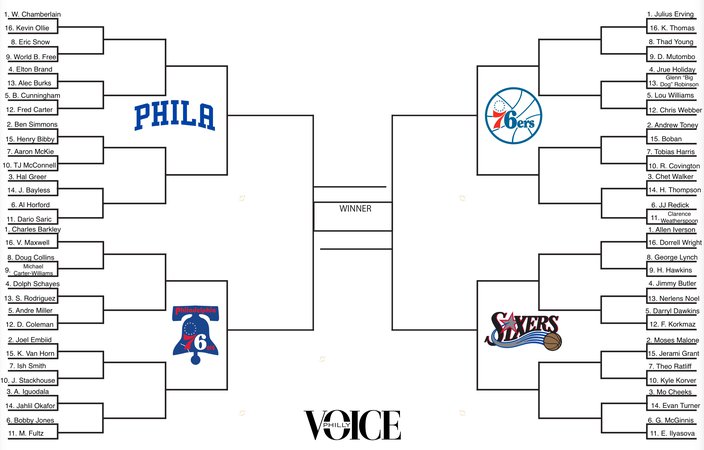
March 24, 2020
The absence of March Madness in our lives has been a real bummer during the COVID-19 outbreak, even for people who stray more toward professional basketball. There are excuses to day drink on a weekday, excessive opportunities to gamble, and sports on television from noon until midnight for an entire weekend. You can't beat it, so the question was simple: How do we come up with another bracket that we can argue about without sports on?
So now I ask you the question: Who would win in an all-time Sixers one-on-one tournament comprised of players of all skill sets from different eras?
You would never know this based on how easy it is to throw money away in your office pool every year, but creating a bracket for different subjects is harder than it seems. Especially so for basketball — a lot of the different categories end up breaking down in groups of five or groups of three, which makes it hard to do a traditional bracket of 64. And, it was rough to learn on the fly, all the different online bracket creators required different orderings of your chosen selections to generate brackets, so there was a lot of wasted time figuring out how to turn this into viewable fashion.
Here's what I settled on.
(If you want a direct link to the photo with a better/closer view, you can check out the bracket here.)
These aren't the "best" 64 players, necessarily, but 64 players from an assortment of eras and categories that I initially was going to divide by playstyles (playmakers, scorers, finishers, and potpourri), before realizing you could put four or five of the greatest players in franchise history into the "scorer" category. I tried to account for some combination of impact, longevity, peak value, etc., with the first goal to split up the players I would consider to be the Sixers' version of Mt. Rushmore — Wilt Chamberlain, Julius Erving, Allen Iverson, and Charles Barkley.
Critically, the players were not strictly seeded based on how good they would be in a one-on-one setting. That's the part that I think will make this interesting, because certain lower seeds might have a chance to go on upset runs as a result because they're either too big or too fast for their opponent to deal with. It is like the NCAA Tournament in that styles may tilt the fights.
The rules:
Other than that, use your best judgment. Good basketball players are better than bad basketball players. Today, we focus on the Wilt Chamberlain portion of the bracket. Consider the following eight matchups and vote accordingly.
Having trouble seeing the polls? Try clicking here.
Follow Kyle on Twitter: @KyleNeubeck
Like us on Facebook: PhillyVoice Sports
Subscribe to Kyle's Sixers podcast "The New Slant" on Apple, Google, and Spotify
 Matt Mullin/for PhillyVoice
Matt Mullin/for PhillyVoice